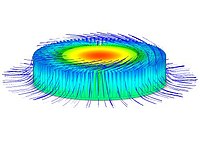
Photo from wikipedia
Fluid warmers minimise accidental peri-operative hypothermia and reduce the incidence of adverse events due to hypothermia such as coagulopathy, metabolic acidosis and impaired immune response [1, 2]. A recent publication… Click to show full abstract
Fluid warmers minimise accidental peri-operative hypothermia and reduce the incidence of adverse events due to hypothermia such as coagulopathy, metabolic acidosis and impaired immune response [1, 2]. A recent publication by Perl et al. [3] evaluated the aluminium content released to the perfusate solution when using specific fluid warming devices containing an aluminium block in the fluid path, at flow rates ranging from 2– 8 ml.min . The Level 1 Fast Flow Fluid Warmer is a rapid infusion device that utilises a passivated anodised aluminium heat exchanger within the fluid path. This device is designed to deliver warmed perfusates at rapid rates, 30– 1100 ml.min , in clinical scenarios where prompt delivery of large volume of warmed fluids is critical to sustain life, such as trauma, postpartum haemorrhage and organ transplantation. We conducted a study to evaluate the level of aluminium leaching from the Level 1 during infusion of various solutions. The Level 1 system (Model H-1025 warmer and DI-100 disposable, Smiths Medical, Minneapolis, MN, USA) was assessed for aluminium leaching with three perfusion solutions: saline; lactated Ringer’s (a balanced salt solution); and heparinised whole blood, at a constant flow rate of 30 ml.min , an indicated flow rate cited in the device’s Instructions for Use. The system was pre-warmed to an operating temperature of 41°C, then the fluid was passed through the device at the defined flow rate for 60 min and collected in a reservoir. Each fluid was perfused through this system, with samples collected at baseline and at each subsequent 10-min interval up to 60 min. Three replicates of each fluid were independently perfused through a warming unit with a new disposable warming unit. Aluminium content from the cumulative collection reservoir was also quantified. Inductively coupled plasma mass spectrometry was used to quantify aluminium using MassHunter Software. A standard curve was generated using calibration standards and the lower limit of quantification for crystalloid solutions was 1 lg.l 1 and 5 lg.l 1 for whole blood. Aluminium leachate concentration varies with perfusion solution.
Journal Title: Anaesthesia
Year Published: 2020
Link to full text (if available)
Share on Social Media: Sign Up to like & get
recommendations!